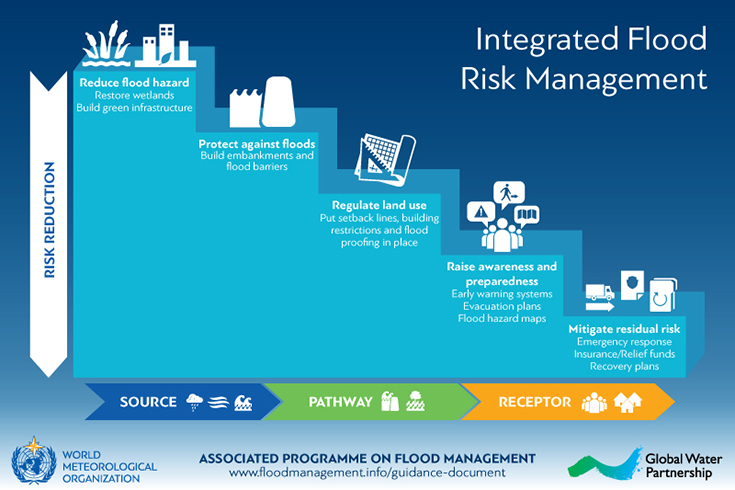New guidance supports integrated flood management
Floods are the most common natural disaster with the largest impacts on society. Official statistics show a gradual decrease in the number of fatalities thanks to better early warnings, but flood damage appears to be increasing because of economic growth, and lack of prevention measures and flood-sensitive land-use planning.

The Integrated Flood Management (IFM) approach aims to maximise the productivity and efficient use of floodplains and coastal zones, while minimising the loss of life and impact on livelihoods and assets through protective measures. Absolute protection from flooding, however, is impossible. In planning for IFM, therefore, there is a need to decide what level of risk is acceptable, to decide how safe is safe enough.
The Associated Programme on Flood Management is 15-year-old joint Global Water Partnership and WMO project focusing on the implementation of integrated flood management in policy and practice. This includes a shift from the ‘classical’ strategy of reactive disaster response, to proactive risk reduction. To support this shift, Deltares and APFM have developed Selecting Measures and Designing Strategies for Integrated Flood Management, a concise guidance document on the design of strategies for IFM.
“This new guide serves as the operational link between the policy and tool papers previously published by the Associated Programme on Flood Management (APFM),” said Johannes Cullman, Director of the World Meteorological Organization (WMO) Climate and Water Department.
“The guidance document includes a comprehensive overview of structural and non-structural measures, arranged in the chain from flood hazard to flood impact. These measures are the building blocks for designing well-balanced strategies aimed at reducing flood risk,” said Marcel Marchand, Deltares expert on coastal zone and flood risk management, and co-author of the publication. Such measures range from restoring wetlands and building green infrastructure to implementing early warning systems and mapping flood hazards.
“The process of developing a successful strategy should comprise a blend of ‘top-down’ and ‘bottom-up’ approaches,” said Herman van der Most, Deltares strategic advisor in flood risk management and co-author of the publication. A top-down approach will produce a strategic framework of coherent strategy development, whereas a bottom-up approach will enhance stakeholder engagement and promote local linkages to other policy domains, such as urban development, nature restoration, and the like.
The guidance document presents a policy analysis and planning framework to guide the steps of IFM. This framework reflects the policy cycle and puts stakeholder engagement and open and transparent communication at its core. Planning for IFM is approached as an iterative process working towards risk-informed decision-making.
The document reflects experiences on how risk-informed decision-making and preventive measures pay off compared to a reactive, event-driven disaster response: more lives saved and fewer assets damaged at less costs. As such it, contributes to the implementation of the objectives of the Sendai Framework on Disaster Risk Reduction.
The guidance document was developed by the APFM Technical Support Unit in close co-operation with Deltares, with the support of the Swiss Federal Office for the Environment and the Netherlands’ Ministry of Infrastructure and Environment.